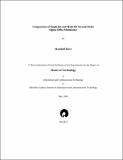Comparison of single-bit and multi-bit second order sigma-delta modulators
Abstract
This work deals with comparison of Single-bit and Multi-bit Second Order Sigma-Delta Modulators at system level for various performance metrics and different circuit nonidealities. For this work of comparison, Boser-Wooley second order sigma-delta modulator architecture was chosen for its stability and ease of implementation. Boser-Wooley singlebit and three-bit second order sigma-delta modulators employing non-ideal operational amplifiers that is operational amplifiers with finite dc gain, limited bandwidth and limited slew rate are modelled in MATLAB 6.5. The effects of these implementation imperfections on Total Harmonic Distortion, Signal To Noise Ratio and Dynamic Range of single-bit and multi-bit sigma-delta modulators are analyzed and from that the specifications of operational amplifier are derived.
The single-bit and three-bit sigma-delta modulators designed for speech applications are implemented in 0.35 micron SCMOS technology using fully differential switched capacitor circuits with dual polarity supply voltage levels. The basic analog building blocks of sigma-delta modulators like operational amplifier with Common Mode Feedback Circuit (CMFB) and comparator-latch are designed for the derived specifications, considering the design trade-offs. The switched capacitor integrators with the input stage incorporating feedback Digital to Analog Converter (DAC) is designed and implemented for three-bit sigma-delta modulator. Finally, the performance of single-bit and multi-bit sigma-delta modulators in terms of Total Harmonic Distortion, Signal to Noise Ratio and Dynamic Range is analyzed.
The behavioural modelling of sigma-delta modulators indicates that the pole error in the integrator transfer function caused by finite small signal gain of an operational amplifier increases the quantization noise floor in single-bit and three-bit sigma-delta modulators by the same amount. Small gain-errors caused by finite bandwidth of operational amplifier do not degrade the performance of single-bit as well as three-bit sigma-delta modulators. The slew rate requirement of a single-bit sigma-delta modulator is much stringent than that of a three-bit sigma-delta modulator.
Collections
- M Tech Dissertations [923]

